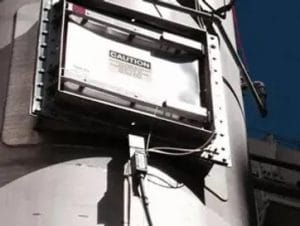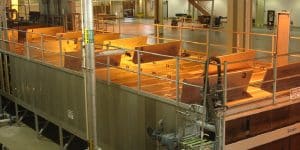 Explosion relief doors and devices are essential safety mechanisms that protect expensive manufacturing equipment and save human lives. They are designed to burst, rupture, or open at a predetermined pressure, thereby eliminating the risk of an explosion.
Explosion relief doors and devices are essential safety mechanisms that protect expensive manufacturing equipment and save human lives. They are designed to burst, rupture, or open at a predetermined pressure, thereby eliminating the risk of an explosion.
Read on to learn more about the various types of explosion relief devices, when you would use one over another, and the different rules and regulations that govern their use.
Types of Explosion Relief Devices
There are several different types of devices that allow for the safe release of built-up pressure in manufacturing equipment:
Explosion Doors
Also known as rupture doors, these devices are built out of a lightweight, high-strength metal honeycomb metal coupled with a magnetic mechanism and calibrated pressure-relieving arms.
They’re secured to a strong door frame, which is then mounted directly upon the vessel it will protect. Explosion doors come in several configurations, such as:
- Re-usable
- Self-reclosing
- Self-destructive
- Non-self-re-closing
Additional options include access cages, door opening stops, and an open door switch, which incorporate extra layers of protection.
After an explosion event has occurred, the door can be reset and re-sealed. This saves both time and money compared to alternative devices.
Explosion Vents
Also known as rupture discs, an explosion vent is a scribed metal sheet (membrane) that’s attached to a frame and opening in the vessel that it protects. They’re made out of several standard or custom metal materials or a composite film/metal sandwich.
Scribe lines are incorporated into the metal membrane when a more controlled breakage scenario is required.
Tension helps keep the membrane in place until enough pressure builds up that surpasses the predetermined parameters. The vent then bursts open and relieves the pressure inside the vessel.
Explosion vents come in four different configurations:
- Square
- Rectangular
- Domed (designed for extreme vacuums)
- Round
There are a few potential downsides to using a vent. They’re susceptible to fatigue failures on the scribe lines and require regular maintenance to check for damage. They also need to be completely replaced when an explosion event occurs.
Vacuum Relief Valves
They’re designed to open (and remain open) at predetermined over-pressures. In situations where catastrophic conditions can occur, it’s advisable to utilize a vacuum relief valve in conjunction with other explosion relief protection methods, such as discs or membranes.
Specific Applications
There are several circumstances in which you might opt for one device over another. Some of those include:
Downtime
Many manufacturers will opt for explosion doors over vents if downtime is a consideration. When a vent fails, it must be replaced entirely, whereas doors just need to be physically reset and returned to their original pre-event condition.
The rupture disc also might be located in a place that’s hard for maintenance personnel to reach. If such a situation occurs, the machinery could require partial or full disassembly for replacement.
Visibility
Explosion doors allow for production to view the contents of the vessel, whereas explosion vents do not afford the same visibility.
Size
There is almost no inertia created when a vent opens during an explosion. This allows them to work very well on vessels of all sizes and in various placement configurations.
Pressure
Explosion doors only work in the 8-30 inch pressure range. Anything outside of that will require another explosion relief solution.
Rules and Regulations
There are several rules, regulations, and governing agencies that dictate the usage of an explosion relief device. Some of these include:
- AHJ – Authority Having Jurisdiction
- National Standards – This includes Factory Mutual Global (FM) and the National Fire Protection Association (NFPA).
- European – ATEX enabled
- Code Bodies – Local, State/Provincial, Regional, National (OSHA and MSHA, for example)
- Other Parties – Insurance companies, management, safety engineers
Learn More About Explosion Relief Devices
Determining what explosion relief device will work for your application comes down to your processes, capabilities, and requirements.
At Smart Machine Technologies, we can help you choose the right device for your manufacturing facility.





 Contract
Contract Food & Bev
Food & Bev